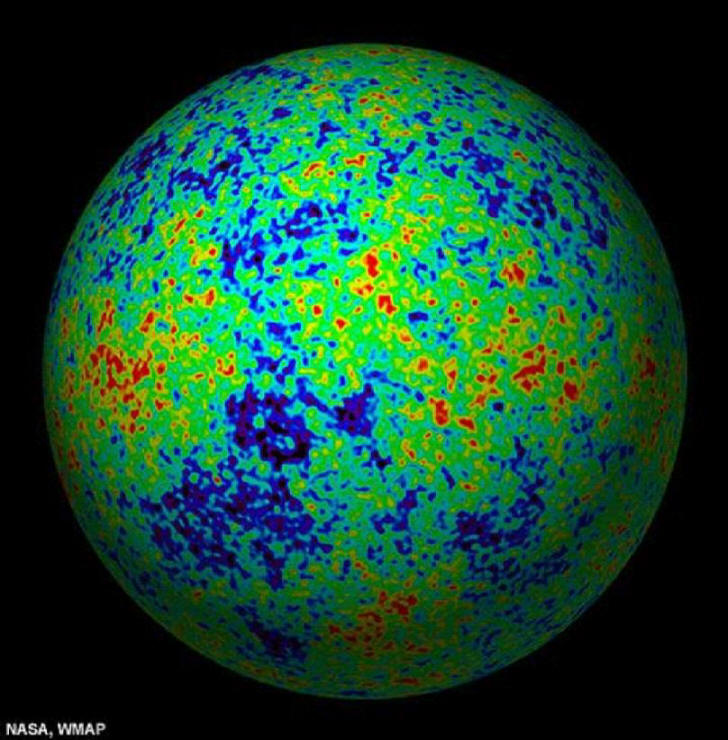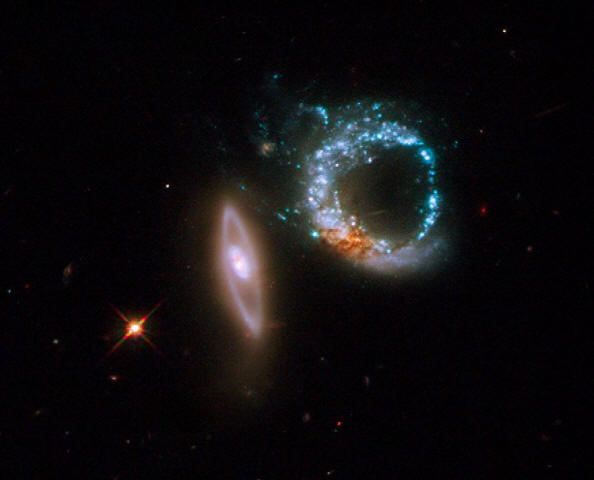Part I
http://www.thunderbolts.info/tpod/2009/arch09/091215light.htm
Part II
http://www.thunderbolts.info/tpod/2009/arch09/091217light2.htm
Be Well.
David

Cosmic microwave background (CMB) radiation projected onto a sphere. Credit: NASA/WMAP
Faster Than Light: Part One
Dec 15, 2009
Today, cosmology is dominated by the Big Bang theory. The theory's major premise is that there was once a void containing no matter, no space, and no time. For some reason not explained by the scientists who support the theory, an irruption of energy from another realm of existence replaced the void with what eventually became the present Universe.
The Big Bang theory was postulated because the astronomer Edwin Hubble, using the 100-inch telescope at Mt. Wilson observatory, believed that he had observed remote galaxies receding from the Milky Way. The most surprising piece of his recorded data was not the recession itself, but the high velocities associated with his measurements. According to his calculations, some galaxies were traveling away from his observatory at thousands of kilometers per second.
Hubble arrived at his conclusion because of what was later to be called the "redshift" of light frequencies in spectrograms from his galactic images. Adapting the Doppler effect (named for the Austrian physicist Christian Doppler, who came up with the idea in 1842) to the spectra of various galaxies, Hubble thought that the change in location of particular elemental signatures called Fraunhofer lines (for the German physicist Joseph von Fraunhofer) indicated that the lightwaves had been shifted toward the red end of the spectrum by an apparent recessional velocity.
Fraunhofer lines are supposed to occur at specific frequencies identified in the spectrum by the kind of element that is absorbing the light. If they are in a different location, then they have been Doppler-shifted because of the element's acceleration. This forms the backbone of galactic-scale distance calculations and the supposed speed of recession that the galaxies display. Using this system of "redshift" some galaxies are measured to be moving away from Earth at an unbelievable 90 percent of light-speed.
All that we see and experience is supposed to have been born in the Big Bang explosion, so the original inertia imparted to the Universe came from that preternatural event. Since the distances and the recessional velocities of objects are correlated with a time-scale, something like a galaxy or a quasi-stellar object (QSO) that is 10 billion light-years away is also thought to be as it was 10 billion years ago. Astronomers are seeing ancient light that has been traveling through space for 10 billion years before finally impinging on their detectors.
The current estimate for the age of the Universe is 13.7 billion years, based on data from powerful telescopes that are supposed to be capable of detecting galaxies that approach that distance from Earth. As mentioned, distance and time are thought to be related to each other because of redshift, so as far as we can see into the Universe provides information that determines how old we perceive it to be. In other words, the diameter of the observable Universe should be approximately 27.4 billion light-years.
There is a conundrum associated with that figure, however. According to a current press release, the Universe is thought to be 156 billion light-years in diameter and not 27.4 billion! How can this be? The answer, according to theoretical physicists, is inflation.
Astrophysicists of the recent past were dismayed when their observations seemed to indicate greater complexity in the early Universe than should exist. As the principle of inflation states, though, it is not merely the acceleration from the Big Bang that is affecting the spectra of remote galaxies and QSOs, but that the space in which they are embedded is expanding.
If it requires X amount of time for a galaxy to form and the Universe is Y years old, then a galaxy should not exist at time-distances less than Y minus X. When such formations were seen, as far as the relevant theories are concerned, some other explanation had to be added to the Big Bang hypothesis to account for them.
So, objects that appear to be redshifted to extreme distances may not be as old as their spectra suggest: they are moving along with the expansion of space. Indeed, as the inflationary theory proposes, they are not as old as they appear to be, they are simply "farther away." This dichotomy seems to demand that the early Universe was expanding faster than the speed of light, since its "size" is more than 11 times greater than its age.
Edwin Hubble's observations of galactic distances versus speed of recession led to another quandary: galaxies that are far enough away would move so fast that their velocities would exceed the speed of light. This is known as the universal horizon, or the Hubble radius. It is the point beyond which our instruments can never see, because the light from over that horizon will never catch up to the greater than light speed expansion of space.
The theory of Special Relativity (SR) does not allow any object to reach the speed of light, let alone exceed it, so how do space scientists deal with the dilemma? They do so by ignoring the restrictions of SR and resorting instead to the General Theory of relativity where such restrictions do not exist. Since no information can be transmitted from beyond the Hubble radius, no violation of relativity occurs.
How did these twists and turns in ideas, as well as the warping of time and space come about? They are the direct result of the assumption that redshift correlates with distance. Modern cosmological systems are all built, without exception, on that assumption. What if Hubble's original premise was flawed? What if redshift is really a red herring? Where then shall we turn for an explanation of what we observe? We turn to the work of Halton Arp, an astronomer whose reputation should be at least the equal of Edwin Hubble's.
Stephen Smith

Interacting ring galaxies designated as Arp 147. Credit: NASA, ESA, and M. Livio (STScI)
Faster Than Light: Part Two
Dec 17 2009
In the 1960s astronomers discovered quasi-stellar objects, better known as quasars. They have extremely large redshifts, implying that they are located near the farthest edge of the observable Universe. Quasars are referred to as "quasi-stellar" because they are relatively small, often little more than a light-year in apparent diameter, at their assumed distance, yet emit so much energy that they are thought to be the most powerful continuously radiant objects in the Universe.
The only other active energy sources detectable at such vast distances are gamma ray bursters (GRB). However, GRBs last for mere minutes, whereas quasars shine continuously in output. They remain as bright as when then were first discovered.
Some astronomers soon found that many quasars are associated with spiral galaxies (like M82) and appear to be near the galaxy instead of billions of light-years distant. Based on other data, such as quasars' anomalous apparent brightness when compared with their redshifts, Hubble's expanding Universe theory was called into question.
Long before the quasar problem arose, though, Edwin Hubble himself was moved to suggest that inflation might not have taken place in the "early" Universe. He thought that new observational data was necessary in order to decide whether it was definitive. In 1947, he was waiting for the new 200-inch telescope at Mt. Palomar to be built:
"It seems likely that redshift may not be due to an expanding Universe, and much of the speculations on the structure of the universe may require re-examination... We may predict with confidence that the 200-inch will tell us whether the red-shifts must be accepted as evidence of a rapidly expanding Universe, or attributed to some new principle of nature." (Publications of the Astronomical Society of the Pacific Vol. 59, No. 349).
Unfortunately, nothing definitive has resulted from astronomers working with the Hale telescope or the many space-borne telescopes that have been launched since then. Instead, redshift and inflation have become something of a dogma among the astronomical community and new, ever more arcane mathematical excursions have been added to the mix, as was discussed in part one.
Although many observations contradict the consensus view, and have been doing so for 40 years or more, those data are ignored or marginalized. High redshift quasars, as previously mentioned, are found in axial alignment with galaxies that possess substantially lower redshift. Indeed, they are sometimes connected to those lower redshift galaxies by "bridges" of luminous material.
Halton Arp was the lone voice among a crowd of scientists who conformed to the standard Big Bang model when he began to publish papers that did not demonstrate that inflation—or the Big Bang hypothesis—was valid. As Edwin Hubble predicted, Arp's research using the 200-inch Hale reflector demonstrated "some new principle of nature."
One of the more interesting images that substantiates the need for a revised cosmology is NGC 4319 and its companion quasar, Markarian 205. Arp called attention to the fact that the lower redshift galaxy is physically connected to the higher redshift quasar. A filament between the two objects violates the measured distances because no such connection should be possible. After all, NGC 4319 (from redshift calculations) is said to be about 600 million light-years from Earth, while Markarian 205 is around a billion light-years away.
If these objects are physically connected they must reside locally with each other at the same distance from Earth. The discrepancy in their redshifts has to be from some other factor not related to their distances—there must be something intrinsic to their makeup that leads to the deviation.
Arp assembled a Catalog of Discrepant Redshift Associations
Arp speculates that the redshift measurement of quasars is composed not of a velocity value alone, but also depends on what he calls "intrinsic redshift." Intrinsic redshift is a property of matter, like mass or charge, and can change over time. According to his theory, when quasars are ejected from a parent galaxy they possess a high intrinsic redshift, z = 2 or greater.
As the quasars move away from their origin within the galactic nucleus, their redshift properties begin to decrease until they reach somewhere near z = 0.3. At that point, the quasar resembles a galaxy, albeit a small one. The inertial moment of ejection is eventually overcome and the mass of the quasar increases while the speed of ejection decreases, until it may become a companion galaxy. It is in that way that galaxies form and age, evolving from highly redshifted quasars, to small irregular galaxies, and then into larger barred spirals.
Other examples of fast-moving quasars in front of slower moving galaxies, or connected to them with luminous filaments, have been observed. NGC 7603, for instance, a distorted spiral galaxy with a single arm, is joined by that arm to a smaller companion with a much higher redshift. Within the bright material of the arm are two other objects, each with redshifts different from the galaxy pair.
There is nothing conclusive in the mainstream scientific journals about Arp's data as of this writing. His telescope time was cut off many years ago by the decision makers who allot that time to various research groups. His revelations concerning problems with consensus dogma were considered too intolerable, so he was summarily censured by his peers. However, the evidence he continues to gather and promote ought to make us stop and think: is the Big Bang dead? How big and how old is the Universe if redshift readings are not reliable indicators of distance?
Stephen Smith that describes anomalous structure or physical links among objects with radically different redshifts. Some of the observations show quasar pairs being ejected in opposite directions from active galaxies. This led to the so-called ejection model of galaxy formation. In brief, high redshift quasars around galaxies, such as the aforementioned M82, are the "daughters" of the mature galaxy. Their various redshifts do not indicate distance, but age from the time of ejection.





No comments:
Post a Comment